
Australian Native Birds
Smaller Birds
& Honeyeaters
& Honeyeaters
Robins, wrens, finches
and honeyeaters, etc
and honeyeaters, etc
The first part of this webpage could have been called "Nervous Little Birds" due to their flittering flighty nature - which makes them more difficult to photograph.
As with the Larger Birds Group, it is an arbitrary grouping to facilitate finding birds on this website.
25-30cm (10-12 inches) has been chosen as the size limit of the group. This is measured from bill tip to tail tip.
As a guide, magpies and seagulls are around 40cm - while wrens and robins are around 15cm.
The second part of the webpage is the honeyeaters (Family Meliphagidae) which includes honeyeaters, wattlebirds, friarbirds, miners, spinebills and chats.
There are about 75 members of the honeyeater family in Australia - twice that many worldwide.
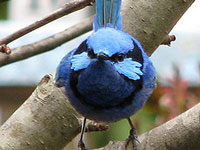 Splendid Fairy-wren
Splendid Fairy-wren
(Albany, WA)
The easiest to identify as it is all blue.
Photo by Ron North
Here's two images from Margaret River, WA. The first image shows a male and female; the second image shows a female.
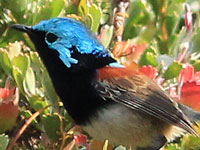 Red-winged Fairy-wren
Red-winged Fairy-wren
(Albany, WA)
The Red-winged Fairy Wren is hard to distinguish from three very similar relatives. Its location and silvery-blue mantle helped greatly.
Here's an image of a moulting male.
Here's an image of a moulting male.
Both photos by Ron North
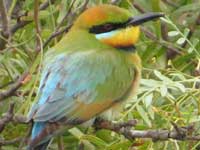 Rainbow Bee-eater
Rainbow Bee-eater
(Wallaroo, SA)
Found throughout Australia - except the more arid areas and Tasmania. It is known for pursuing and catching insects in flight.
Photo by Jimmy Hislop
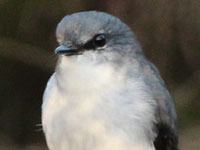 White-breasted Robin
White-breasted Robin
(Albany, WA)
Its even colours, black lores and location identifies it. It is found in the south-west of Western Australia.
[A bird's lore is the patch between its beak and eyes.]
[A bird's lore is the patch between its beak and eyes.]
Photo by Ron North
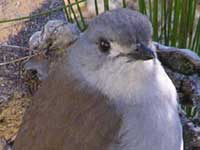 Grey Shrike-thrush
Grey Shrike-thrush
(male)
(Leura, NSW)
The Grey Shrike-thrush is found all over Australia, and as with many birds it has slight variations in this area. The female has a white ring around its eyes.
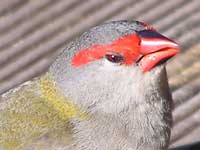 Red-browed Finch
Red-browed Finch
(Leura, NSW)
This poor little bird crashed into our window, and was stunned for quite awhile before recovering and flying away. (It's left foot is not caught.) It is found along
the eastern coast and tablelands from Cape York to Adelaide.
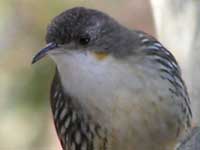 White-throated Treecreeper
White-throated Treecreeper
(female)
(Leura, NSW)
The White-throated Treecreeper is found on the coast and adjacent ranges from mid Queensland around to Adelaide. The female has an orange mark on her cheek. Their back is a solid browny-grey colour.
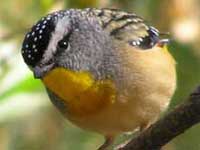 Spotted Pardalote
Spotted Pardalote
(male)
(Lane Cove NP, NSW)
The Spotted Pardalote is found in the forests and woodland in the southern part of Australia. The female has a cream throat.
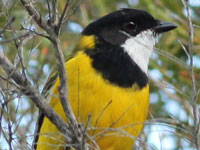 Golden Whistler
Golden Whistler
(male)
(Albany, WA)
Found along the eastern and southern seaboard and ranges and Tasmania.
Very similar to the Mangrove Golden whistler which is found along the northern seaboard. Photo by Ron North
Very similar to the Mangrove Golden whistler which is found along the northern seaboard. Photo by Ron North
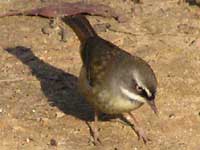 White-browed Scrubwren
White-browed Scrubwren
(Lane Cove NP, NSW)
One of many busy little brown birds. It is found along the coast and adjacent ranges in the southern half of Australia.
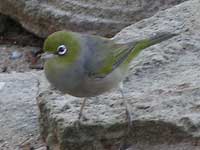 Silvereye
Silvereye
(Dutton Bay, SA)
Easily identified - if you can get close to this nervous little bird. It is also found along the coast and adjacent ranges in the southern half of Australia.
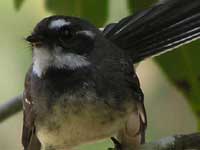 Grey Fantail
Grey Fantail
(Lane Cove NP, NSW)
A member of the unmistakable Fantail family - which includes the Willie Wagtail. The Grey Fantail is found throughout Australia.
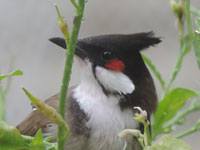 Red-whiskered Bulbul
Red-whiskered Bulbul
(introduced)
(Leura, NSW)
This reasonably well-behaved bird was introduced in the 1880s into Sydney.
We have a pair that nest most years in our garden and help out in the veggie patch. Here's another image.
We have a pair that nest most years in our garden and help out in the veggie patch. Here's another image.
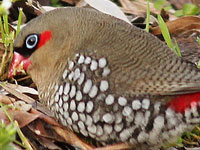 Red-eared Firetail
Red-eared Firetail
(Albany, WA)
There are 5 or so firetail finches - fortunately they tend to have their own discrete area, so are relatively easy to identify.
The Red-eared Firetail is found in south-western WA. Photo by Ron North
The Red-eared Firetail is found in south-western WA. Photo by Ron North
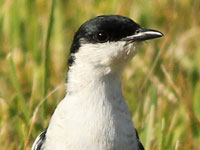 White-winged Triller
White-winged Triller
(male)
(Albany, WA)
This is a breeding male.
Just like the fairy-wrens, the male sports very distinctive plumage when breeding. The female and non-breeding males are brownish and don't have a solid black head. Photo by Ron North
Just like the fairy-wrens, the male sports very distinctive plumage when breeding. The female and non-breeding males are brownish and don't have a solid black head. Photo by Ron North
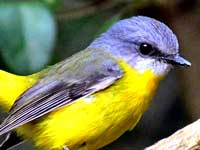 Eastern Yellow Robin
Eastern Yellow Robin
(Brunswick Heads, NSW)
This delightful little bird, is found along the eastern seaboard and ranges. A frequent visitor to my garden it flicks its tail while sitting hunting for food in the garden.
Photo by Alan Lymbery
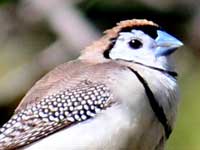 Double-barred Finch
Double-barred Finch
(Byron Bay, NSW)
Recognised by its two black bands, this member of the finch family is found from in NSW, Qld and the northern parts of NT and WA.
Photo by Alan Lymbery
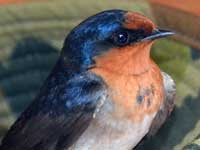 Welcome Swallow
Welcome Swallow
(Brunswick Heads, NSW)
Found virtually throughout Australia, the Welcome Swallow has a characteristic long forked tail.
This swallow came into Alan's van and seemed quite content to sit there while being photographed.
Here's another image.
This swallow came into Alan's van and seemed quite content to sit there while being photographed.
Here's another image.
Photos by Alan Lymbery
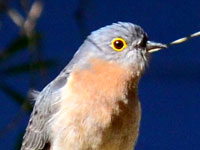 Fan-tailed Cuckoo
Fan-tailed Cuckoo
(Byron Bay, NSW)
Distinguished from other cuckoos by its full chestnut breast and yellow eye ring, it choses fairy-wrens and thornbills nests to lay its eggs.
Photo by Alan Lymbery
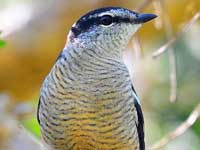 Varied Triller
Varied Triller
(Wooli, NSW)
Found in forested areas on the coast and hinterland from Sydney around the "top end" to Broome, WA.
Here's another image.
Here's another image.
Photo by Alan Lymbery
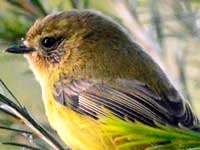 Yellow Thornbill
Yellow Thornbill
(Pambula, NSW)
Recognised by the streaked ear coverts. It ranges in eastern Australia from Adelaide to Cairns.
[Ear coverts are behind and below the eye.]
[Ear coverts are behind and below the eye.]
Photo by Alan Lymbery
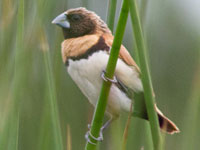 Chestnut-breasted Mannikin
Chestnut-breasted Mannikin
(Wetland near Penrith, NSW)
Its black face and black bar across its chest helps identify this finch. Its found from Sydney up and around to Broome preferring grass and farm lands.
Photo by Katie Cordes
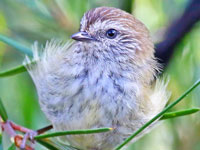 Striated Thornbill
Striated Thornbill
(Blackheath, NSW)
Australia's dozen thornbills are among its smallest birds.
The streaking over the Striated Thornbill's forehead helps identify it.
The streaking over the Striated Thornbill's forehead helps identify it.
Photo by John French
The Honeyeater Family - Family Meliphagidae.
There are over 50 native birds called honeyeater Australia.
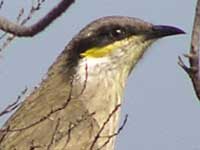 Singing Honeyeater
Singing Honeyeater
(Port Neill, SA)
Found throughout Australia except on the eastern seaboard. The Birds In Backyards website provides further information.
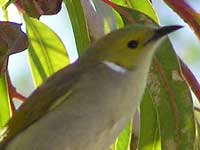 White-plumed Honeyeater
White-plumed Honeyeater
(Quorn, SA)
Identified by the white plume on its neck, this honeyeater is found in most parts of Australia except the tropical north.
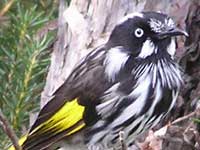 New Holland Honeyeater
New Holland Honeyeater
(Leura, NSW)
New Holland Honeyeaters can be distinguished by the white around their eyes. They are found in south-eastern Australia and the south-west of WA.
New Holland was an early name for Australia.
Here's an image taken by John French in Blackheath, NSW.
New Holland was an early name for Australia.
Here's an image taken by John French in Blackheath, NSW.
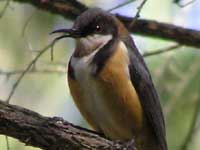 Eastern Spinebill
Eastern Spinebill
(female)
(Lane Cove NP, NSW)
The female Eastern Spinebill has an olive-grey crown, whereas the male has a glossy black head.
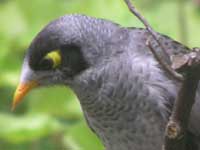 Noisy Miner
Noisy Miner
(Cheltenham, NSW)
Found on the east coast and hinterland from northern Queensland to Adelaide.
A fearless bird that "shapes up" to Magpies and Currawongs. Its distinctive cry of alarm when a threat appears, rapidly brings the whole family around.
Here's an image by Martin Kandilas
A fearless bird that "shapes up" to Magpies and Currawongs. Its distinctive cry of alarm when a threat appears, rapidly brings the whole family around.
Here's an image by Martin Kandilas
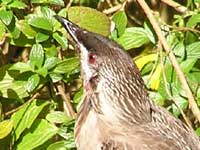 Red Wattlebird
Red Wattlebird
(Cheltenham, NSW)
The Red Wattlebird has a distinctive pinkish red wattle near its ear. Its red eyes also differentiate it from other wattlebirds. The Red Wattlebird is found in the south of all mainland southern states.
Here's an image taken by John French in Blackheath, NSW.
Here's an image taken by John French in Blackheath, NSW.
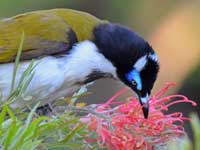 Blue-faced Honeyeater
Blue-faced Honeyeater
(Wagga Wagga, NSW)
Found in woodlands in the Eastern States and the Top End, it's blue face quickly identifies it.
Here's an image of a juvenile (photo taken in Wooli, NSW) - note the green face.
Here's an image of a juvenile (photo taken in Wooli, NSW) - note the green face.
Photos by Alan Lymbery
 Yellow-throated Miner
Yellow-throated Miner
(Kings Canyon, NT)
Found throughout Australia, except the eastern seaboard, Victoria and Tasmania.
It is distinguished from other miners by the yellow skin that runs from its beak.
It is distinguished from other miners by the yellow skin that runs from its beak.
Photo by Rosemary Culos
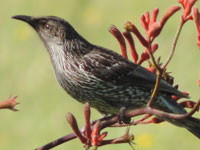 Little Wattlebird
Little Wattlebird
(Orbost, Vic.)
A wattlebird without the wattle. This fellow is found along the coast and nearby ranges from southern Queensland to Adelaide and parts of Tasmania.
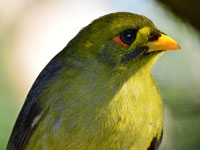 Bell Miner
Bell Miner
(Pambula, NSW)
Found in open forests on the coast and ranges from Melbourne to Gympie in Queensland, this Miner is identified by the orange-red patch behind its eye.
Also known as the Bellbird, it is the subject of Henry Kendall's poem - "Bell Birds".
Also known as the Bellbird, it is the subject of Henry Kendall's poem - "Bell Birds".
Photo by Alan Lymbery
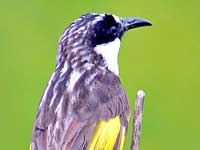 White-cheeked Honeyeater
White-cheeked Honeyeater
(Brunswick Heads, NSW)
Found on the east coast and ranges in NSW and Queensland, and in the South-West of WA, its black iris distinguishes it from the white iris of the New Holland Honeyeater.
Here's another image.
Here's another image.
Photos by Alan Lymbery
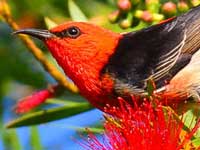 Scarlet Honeyeater
Scarlet Honeyeater
(male)
(Grafton, NSW)
Found on the east coast and ranges from Cairns to Melbourne. The Red-headed Honeyeater is found in the "Top-End".
Here's an image of a female Scarlet Honeyeater from Brunswick Heads, NSW.
Here's an image of a female Scarlet Honeyeater from Brunswick Heads, NSW.
Photos by Alan Lymbery
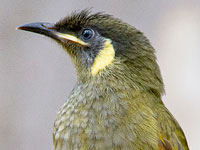 Lewin's Honeyeater
Lewin's Honeyeater
(Woodford, NSW)
The yellow half moon shaped patch on its neck identifies Lewin's Honeyeater. It is found all along the east coast and around to Melbourne.
Here's another image
Here's another image
Photo by Niel Carey
Glossary
ACT - Australian Capital Territory
NP - National Park
NSW - New South Wales
NT - Northern Territory
Qld - Queensland
SA - South Australia
Vic. - Victoria
WA - Western Australia
Copyright © 2024 Waratah Software
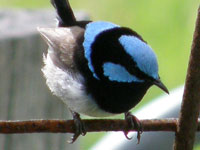 Superb Fairy-wren
Superb Fairy-wren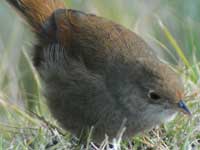 Eastern Bristlebird
Eastern Bristlebird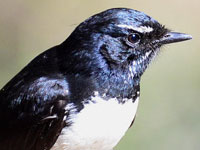 Willie Wagtail
Willie Wagtail